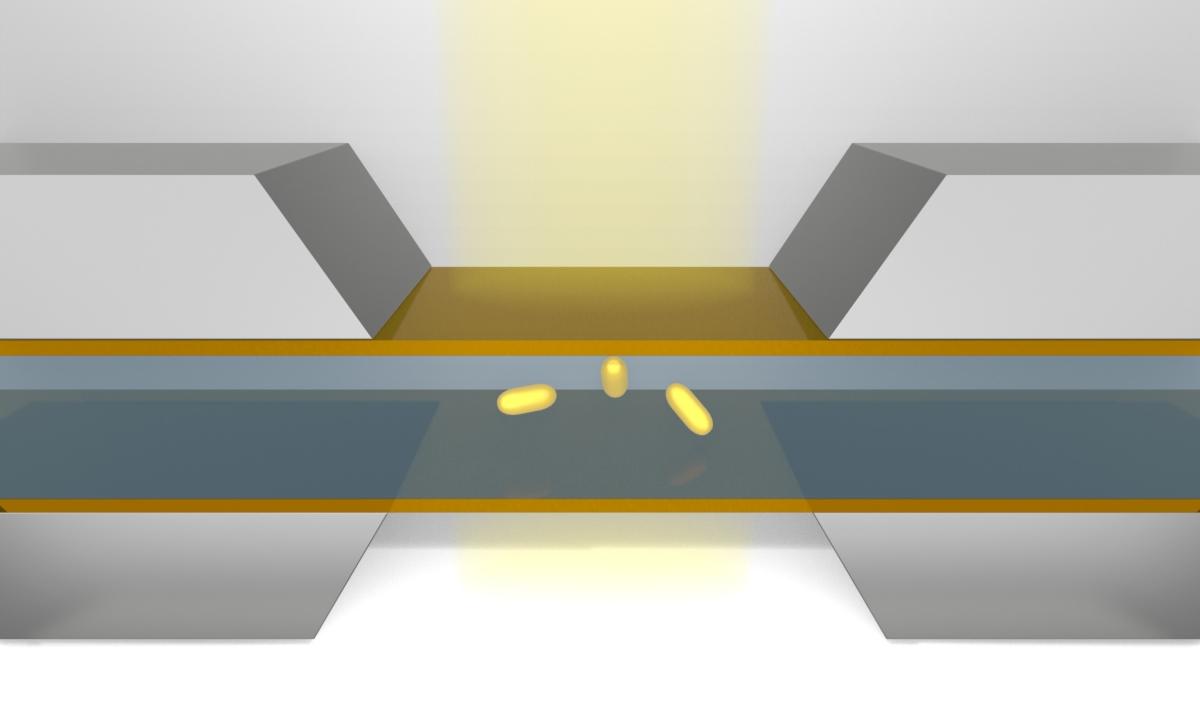
Schematic showing nanoparticles in the microfluidic chamber of liquid-phase transmission electron microscopy
Nanoparticles – the tiniest building blocks of our world – are constantly in motion, bouncing, shifting, and drifting in unpredictable paths shaped by invisible forces and random environmental fluctuations.
Better understanding their movements is key to developing better medicines, materials, and sensors. But observing and interpreting their motion at the atomic scale has presented scientists with major challenges.
However, researchers in Georgia Tech’s School of Chemical and Biomolecular Engineering (ChBE) have developed an artificial intelligence (AI) model that learns the underlying physics governing those movements.
The team’s research, published in Nature Communications, enables scientists to not only analyze, but also generate realistic nanoparticle motion trajectories that are indistinguishable from real experiments, based on thousands of experimental recordings.
A Clearer Window into the Nanoworld
Conventional microscopes, even extremely powerful ones, struggle to observe moving nanoparticles in fluids. And traditional physics-based models, such as Brownian motion, often fail to fully capture the complexity of unpredictable nanoparticle movements, which can be influenced by factors such as viscoelastic fluids, energy barriers, or surface interactions.
To overcome these obstacles, the researchers developed a deep generative model (called LEONARDO) that can analyze and simulate the motion of nanoparticles captured by liquid-phase transmission electron microscopy (LPTEM), allowing scientists to better understand nanoscale interactions invisible to the naked eye. Unlike traditional imaging, LPTEM can observe particles as they move naturally within a microfluidic chamber, capturing motion down to the nanometer and millisecond.
“LEONARDO allows us to move beyond observation to simulation,” said Vida Jamali, assistant professor and Daniel B. Mowrey Faculty Fellow in ChBE@GT. “We can now generate high-fidelity models of nanoscale motion that reflect the actual physical forces at play. LEONARDO helps us not only see what is happening at the nanoscale but also understand why.”
To train and test LEONARDO, the researchers used a model system of gold nanorods diffusing in water. They collected more than 38,000 short trajectories under various experimental conditions, including different particle sizes, frame rates, and electron beam settings. This diversity allowed the model to generalize across a broad range of behaviors and conditions.

Assistant Professor Vida Jamali
The Power of LEONARDO’s Generative AI
What distinguishes LEONARDO is its ability to learn from experimental data while being guided by physical principles, said study lead author Zain Shabeeb, a PhD student in ChBE@GT. LEONARDO uses a specialized “loss function” based on known laws of physics to ensure that its predictions remain grounded in reality, even when the observed behavior is highly complex or random.
“Many machine learning models are like black boxes in that they make predictions, but we don’t always know why,” Shabeeb said. “With LEONARDO, we integrated physical laws directly into the learning process so that the model’s outputs remain interpretable and physically meaningful.”
LEONARDO uses a transformer-based architecture, which is the same kind of model behind many modern language AI applications. Like how a language model learns grammar and syntax, LEONARDO learns the "grammar" of nanoparticle movement, identifying hidden reasons for the ways nanoparticles interact with their environment.
Future Impact
By simulating vast libraries of possible nanoparticle motions, LEONARDO could help train AI systems that automatically control and adjust electron microscopes for optimal imaging, paving the way for “smart” microscopes that adapt in real time, the researchers said.
“Understanding nanoscale motion is of growing importance to many fields, including drug delivery, nanomedicine, polymer science, and quantum technologies,” Jamali said. “By making it easier to interpret particle behavior, LEONARDO could help scientists design better materials, improve targeted therapies, and uncover new fundamental insights into how matter behaves at small scales."
CITATION: Zain Shabeeb , Naisargi Goyal, Pagnaa Attah Nantogmah, and Vida Jamali, “Learning the diffusion of nanoparticles in liquid phase TEM via physics-informed generative AI,” Nature Communications, 2025.